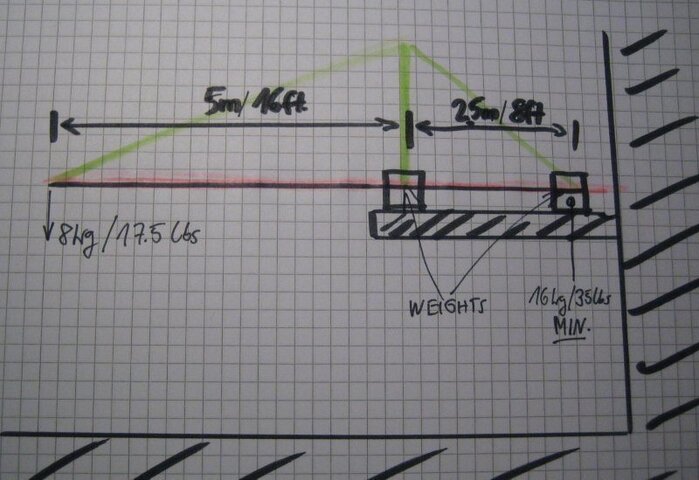Hi guys and girls,
I need your help.
For a film production in mid september, I need to rig three lights (each about 2.5 kg, i.e. 5.5 lbs) above three tables standing in a row. I can't rig from the ceiling (this is a room 10 Meters (33 feet) high from the 19th century!), so I need to rig from a balcony right next to the tables.
The balcony is 2.5 meters (8 feet) in depth.
I've attached a drawn view of this. For safety and easy of calculation, I will assume a single 8 kg (17.5 lbs) weight at the end of the extension bar, rather than the three lights spread across the open width of 5 meters (16 ft).
Now this is all dandy and well, and the counter weight is easily calculated as minimum 16 kg / 35 lbs (not considering the weight of the bar itself yet which must be counterweighted).
Now I did some experiments at a local metal equipment supplyer: when keeping the diameter of the bar under about 5 cm (necessary for being able to grip the lights to it), it will bend too much. Tried this with a steel bar, I guess aluminium will bend even more.
Now one solution would be to add a vertical bar to the extension bar at the edge of the balcony and run a steel wire over it for taking some weight off the end of the bar, taking away some of the bending. This part (vertical bar and steel wire) is drawn green. This is very similar to how a construction crane is built.
The problem is that with that "crane" solution, new problems arise: now the center of weight might end up below the bar, so it has to be stabilized against rolling to its side etc etc.... not sure if this is worth the "engineering muscle"..
Are there any other solutions that you can suggest? Can a lightweight 2-point or 3-point aluminum truss be somehow extended over the balcony edge into the set? As far as I know that are no trusses larger than 6 meters... and usually those are flown at two ends, not at one...
Thanks...
belford.

I need your help.
For a film production in mid september, I need to rig three lights (each about 2.5 kg, i.e. 5.5 lbs) above three tables standing in a row. I can't rig from the ceiling (this is a room 10 Meters (33 feet) high from the 19th century!), so I need to rig from a balcony right next to the tables.
The balcony is 2.5 meters (8 feet) in depth.
I've attached a drawn view of this. For safety and easy of calculation, I will assume a single 8 kg (17.5 lbs) weight at the end of the extension bar, rather than the three lights spread across the open width of 5 meters (16 ft).
Now this is all dandy and well, and the counter weight is easily calculated as minimum 16 kg / 35 lbs (not considering the weight of the bar itself yet which must be counterweighted).
Now I did some experiments at a local metal equipment supplyer: when keeping the diameter of the bar under about 5 cm (necessary for being able to grip the lights to it), it will bend too much. Tried this with a steel bar, I guess aluminium will bend even more.
Now one solution would be to add a vertical bar to the extension bar at the edge of the balcony and run a steel wire over it for taking some weight off the end of the bar, taking away some of the bending. This part (vertical bar and steel wire) is drawn green. This is very similar to how a construction crane is built.
The problem is that with that "crane" solution, new problems arise: now the center of weight might end up below the bar, so it has to be stabilized against rolling to its side etc etc.... not sure if this is worth the "engineering muscle"..
Are there any other solutions that you can suggest? Can a lightweight 2-point or 3-point aluminum truss be somehow extended over the balcony edge into the set? As far as I know that are no trusses larger than 6 meters... and usually those are flown at two ends, not at one...
Thanks...
belford.



